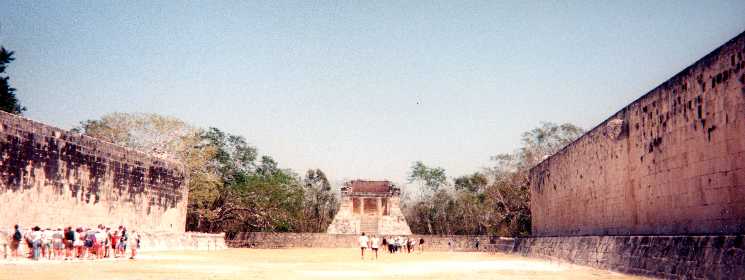

Play Ball! In the Land of the Maya
By Rob Schmidt
"The cheering fans have filled the stadium. The dignitaries are in their seats. The players, in their helmets and pads, have taken the field.
"A signal is given and play begins. One team takes control of the ball, pushing and shooting it down the field. The players lob it to their captain, who fires and...scores! Pandemonium reigns as the home team wins!
"And the opponents? They're losing their heads!"
Does this sound like a typical report from a modern sports arena? It comes from a much more remarkable site. At Chich‚n Itz , on Mexico's Yucat n Peninsula, the ancient Maya played their game of pokta-pok, maneuvering a small ball without their hands or feet. It was a rough-and-tumble sport, and they played for keeps. The losers were beheaded.
The Ball Court of Chich‚n Itz is one of the impressive structures of this old city, which the Maya founded a thousand years before Columbus. Although archaeologists have uncovered courts elsewhere, this one is by far the largest. It is truly colossal in size and shape: two massive parallel walls, almost 40 feet high, bound a grassy space as wide as a football field and nearly twice as long.
High up on each wall, at the field's midpoint, is a single stone ring.
The Ball Court was built with acoustics in mind. Incredibly, a person standing at one end can faintly hear someone at the other speak without shouting. When the Court was full, its walls must have reverberated with sound.
These walls sit on platforms about six feet high. On the front of the ledges are elaborate carvings that repeat at intervals. Here visitors can see the game's central motif:
An ornately-dressed captain holds a large stone blade in one hand and a head, dripping blood, in the other. Facing him, the opposing captain kneels in obeisance, and seven streams of blood spurt out of his headless torso. Six of them end in serpents, but the last transmutes into a bountiful vine. The loser has insured the gods will bless the land with fertility.
Between the ball players is a skull in a circle, symbolizing death. However, the victims didn't consider their fate a punishment, but rather an honor: a chance to sacrifice themselves for the good of the people. They truly believed the gods would reward them.
Experts have tried to piece together how the Maya played the game. It's difficult because our only source of information, besides the Ball Court itself, is the testimony of Indians recorded centuries after the final bout. Even the name, pokta-pok, is in doubt.
We can see each team had seven players, including a captain. Their uniforms consisted of a short skirt, a feathered cap, and padding on their knees, hips, and arms. They carried a small plate or shield in one hand and a bat or club tucked into their belts.
Authorities used to think the players could hit the ball only with parts of their bodies, not with their hands or feet. At no time could the ball touch the ground. The object of the game—and what a challenge it would have been—was to knock the ball through the lofty ring.
However, some have questioned these theories. They point out that scoring would be nearly impossible with only one's elbows and knees. The players probably used their wooden bats and shields, as well as their bodies, to propel the ball.
Let's take another look at a hypothetical game:
The players, gaily bedecked in pendants and plumes of red, green, blue, and orange, stand before the assembled throng. The king and his retinue watch from one end, the mere aristocracy from another, and lesser functionaries line the walls.
After a priest's invocation, the teams break into action. They bat the ball back and forth until one team gains control. It races down the field, bouncing the ball off the walls in precise, well-practiced patterns.
The opponents miss a block and the team passes to its captain, who stands on one of the ledges. The captain dribbles along the wall until he can fire at his ring. If he misses, the ball falls back into play.
But if he scores, the Court rocks with a thunderous commotion. The victims line up and bow their heads, ready to receive...a ritual blow, not a killing one?
That is, we really don't know what happened. The carvings may refer to legends, not actual events. Some experts have even hypothesized that the Maya beheaded the winners, not the losers, though that would have been a powerful incentive to slack off.
Talk about the thrill of victory. And all this without instant replay, beer commercials, or the Goodyear blimp.
The Astrodome and Madison Square Garden may be more famous, but Chich‚n Itz 's Ball Court is just as spectacular. It's one stadium that lives up to its life-and-death billing.
|
. . . |

|
All material © copyright its original owners, except where noted.
Original text and pictures © copyright 2008 by Robert Schmidt.
Copyrighted material is posted under the Fair Use provision of the Copyright Act,
which allows copying for nonprofit educational uses including criticism and commentary.
Comments sent to the publisher become the property of Blue Corn Comics
and may be used in other postings without permission.